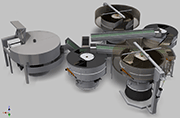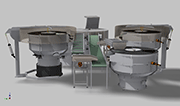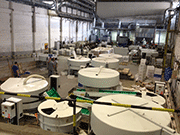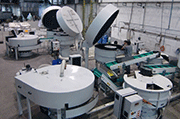E-Archive
Articles
in Vol. 13 - November Issue - Year 2012
Hi-Tech Vibrofinishing

Picture 1

Picture 2

Picture 3

Picture 4
Rollwasch® offers a renewed perspective on vibrofinishing processes with the aim to meet three main interesting needs:
1. Automation "custom made for the user"
2. Environment, quality and cost reduction-wise, innovative vibrofinishing processes
3. Hardware, carefully designed and long-lasting
Let us explore these three prerogatives through the example of a plant articulated on six islands, for a total of 24 vibratory finishing machines, recently delivered to a high production rate "B.R.I.C." country that requested the maximum level of automation, in accordance with local resources and taking into special consideration the possibility of a "flawless management".
Automation "custom made for the user"
The automation of vibrofinishing plants is easier said than done. In fact, everything goes smoothly with just one kind of article to be treated by one kind of media and using one kind of separation grid. However, it gets more difficult when dealing with tens or hundreds of types of articles in different shapes and dimensions, because consumable media need to be evaluated both according to their initial dimensions and to their dimensions once they have been consumed (not to cause any jams, if they get next to each other) and, consequently, the separation grids need to be designed so that a certain line can always work with a certain kind of sieve and optimize the streams.
When adding the management of five or six kinds of batches, used in single or multiple charges depending on the articles to be treated, the situation needs to be dealt with, not only with care and attention, but also keeping in mind the person in charge to manage all load, finishing and unload streams.
Keeping into consideration all of the above and in tight partnership with the customer, Rollwasch® designed, article by article, a way to manages the batches, the kind of container needed (based on volumes and weights of articles to be treated), quantities per batch in number of parts, annual needs per articles and, based on the estimated finishing time, the dimensions of machine, types and capacity.
Referring then to the database with the above-mentioned variables, Rollwasch® has then grouped the different articles in "families", optimizing the stream expectations, and addressing every family towards its own ideal finishing island.
This project was approached thanks to the various finishing tests, a series of calculations, practical evaluations and various simulations.
Many meetings with the customer during the developing phases of the projects have led to the necessary evaluations on the compatibility between the available spaces and the identified resources, besides the automation logics and the attitude of the personnel who will be managing the finishing department.
Months after the preliminary try-out in Italy and the installation/start-up at the customer premises the results are rewarding, thanks to the full satisfaction of the customer.
During a trip aimed at the evaluation of the whole project from Rollwasch® President, Mr. Paolo Redaelli, the customer congratulated the supplier for the balance achieved concerning the high productivity, the automation and the flawless management.
While talking to the department managers and to the shifts managers, Mr. Redaelli was able to find out how much the training had made it easier for the workers to operate the machinery, especially thanks to the user-friendliness of the studied solutions.
Environment, quality and cost reduction-wise, innovative vibrofinishing processes
Finishing solutions existing today thanks to the latest Rollwasch® vibrofinishing plants are featured by the green leaf logo, which represents environmental friendliness.
Aiming at giving the customer the quality standard he expects (nothing more, nothing less), the "eco sustainable" and the "eco compatible" processes can be reached with very convenient costs today.
It is no secret in fact, that polluting less (from the very beginning) implies a significant cost reduction.
At least in Europe, polluting has become expensive.
On the one hand, it is because it’s necessary to set up disposal and purification plants with respective management, capital investments, and maintenance costs, etc.
On the other hand, it is because if the polluting agents are reduced at the start, everything is dealt with at the end of the process with highly reduced management as well as purification/disposal costs, resulting in the final competitiveness of the product as well as in positive impact to our future and to generations to come.
Just to quote an example of one of the most innovative finishing processes Rollwasch® has designed in the recent years, take note of the following points:
a) Microfluid wet processes (patent pending – I), with extremely low water consumption. Rollwasch® recommends combining these processes with the use of rain water, which is very easy to stock throughout the year (no big quantities needed). It is easy to show, through several applications, that it is more convenient to reduce water consumption at the start by using good quality water (such as rain water) to then reduce polluting agents, rather than using big quantities of recycled waste water (closed circuit). This solution (recycling) is always subject to the decreasing quality of the used liquid, which determines the production of batches of lower and unstable quality compared to the one reachable through Microfluid processes. The saline content of the reused liquids suffers in fact from the growing accumulation of polluting agents and, in the case of coagulants or flocculants, also suffers from their influence because they release saline agents and polluting wastes. It is therefore possible to talk about a substantial revolution in water management, especially thanks to the new Microfluid processes.
b) Vibrodry Dry Processes (patent pending – I), used on their own or together with Durogal processes (hardening the surface of metals in light alloys, in pre-plating applications). All dry processes have two natural main limits:
• Safety (ATEX policy on explosion risks, e.g. with metals such as magnesium);
• Practical feasibility, e.g. with oily parts it is almost impossible to conduct dry finishing processes (deburring and polishing) successfully or at a lower cost compared to wet processes;
c) Chemically accelerated deburring processes Abrakem, where the mud reduction and the level of quality reachable in terms of geometry and smoothness of the surface make it possible to define these processes as eco-sustainable – the only limit thereto is that it is only applicable to a small range of iron and martensitic steel alloys with a few exceptions in the case of austenitic steel alloys.
Hardware, carefully designed and long-lasting
It is well known that Rollwasch® manufactures made-in-Italy machines, carefully designed and lasting over time. Moreover, it is very important to bear in mind that Rollwasch® has been manufacturing machines of this quality for 3 generations and still does, despite the general trend to cut all kinds of costs in every possible way and form, at the natural expense of quality.
This guarantees safety, in two ways:
a) From the supplier side, Rollwasch® in this case, the comfort of offering an absolutely reliable product designed in such a way that makes it possible to guarantee the supply of spare parts of excellent quality mainly made in Italy or Europe, except for some rare exceptions when it comes to some control panel devices (often coming from Asia).
b) From the side of the customer, he can be sure he is investing in a long-lasting product, manufactured nationally and featuring all of the advantages related thereto.
Last but not least, Rollwasch® design benefits from constant updates, especially thanks to all research and development activities which are the highlight of this company located in the Brianza area that makes it a point to accept and evaluate all suggestions (especially based on the needs of international customers, often coming from different backgrounds and offering different and challenging worldviews).
The pictures featured in this article show an example of how machinery is designed (Pictures 1 and 2) and started up at the customer’s premises (Pictures 3 and 4).
For Information:
Rollwasch® Italiana S.p.a.
Via San Carlo, 21
20847 Albiate (MB), Italy
Tel. +39.0362.930334
Fax +39.0362.931440
E-mail: info@rollwasch.it
www.rollwasch.it



























